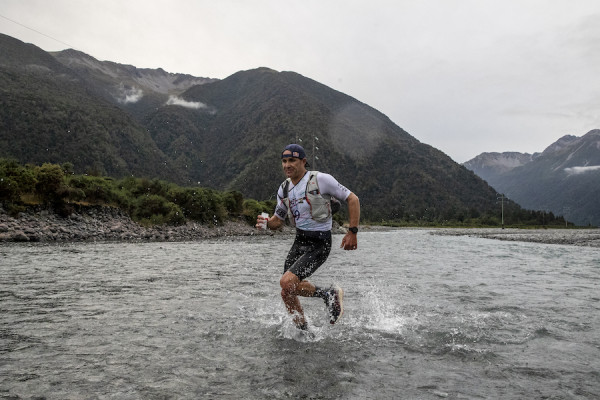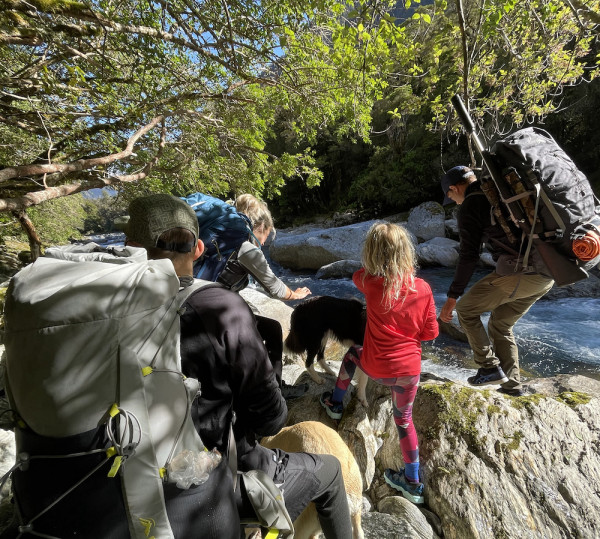Don’t take on a river in the heat of the moment
Braden Currie might be at the top of his game in world Ironman racing, but his roots run deep in off-road and technical backcountry terrain. Earlier this year Braden reunited with his old friend the Kathmandu Coast to Coast, having previously won the event four times, with a last-minute entry due to the postponement of Ironman New Zealand.
This year the Kathmandu Coast to Coast was significantly impacted by heavy rain and the course was altered. Athletes battled with uniquely high river levels on the 30.5km mountain run section, up the Deception River, over Goat Pass and down the Mingha River, through the heart of Arthur’s Pass National Park. Spectators and race officials witnessed runners taking different approaches to their river crossing strategy.
Watching these events unfold, we reached out to Braden and ask him to share his strategies for a safe and successful run over Goat Pass. Understanding his differing approaches to river crossings on an adventure race to river crossings with his family, and his key advice in both situations.
High river levels were definitely a factor at this year’s Coast to Coast. Personally, I really enjoyed it – but intense river conditions are not for everyone. It comes down to skill, experience, fitness, and confidence in that environment. A key point here is that people need to find their own level of safety and comfort when crossing rivers and be aware of potential social pressures that may arise. Have a plan, mentally, to ensure you don’t take on a river on your own in the heat of the moment if you don’t feel comfortable just because everyone else is.
A great example of this was Simone Maier (2022 Women’s Elite Longest Day winner), her strategy was to team up with others before crossing as she recognised the rivers were too high for her to attempt solo – as a race favourite and an incredibly capable and competitive women – you can see how she may have chosen a more ruthless individual approach, but she stood by her conscious decision and it was a really smart choice.

For me, in the race environment when I’m only having to think about myself, and not factor in others like my family, I am prepared to swim if I have to. During the Kathmandu Coast to Coast this year, some of the crossings were waist deep and at times some were strong enough to wash my feet out from underneath me, so I’d literally dive and take 2-3 swim strokes to power through until I found my feet on the bottom again and could walk out. It’s a risky style of racing and not something I’d ever do with kids or people who are not confident in their ability to move fast in technical terrain. But for me, with my training and experience, with a small lightweight running pack, I felt comfortable taking more risks on those rivers. I still approached each crossing with caution, slowing down to assess the conditions and looking for the slower water or for the braided sections, so that I could move faster and safer.
The approach I take with my family looks very different.
With the kids I am always a lot more cautious around rivers because of the strength and power of the water.

When planning a trip with my family that involves river crossings my key considerations are:
1. The scale of the rivers we are going to be crossing.
- I always figure out how big the rivers might be so we know what we are going into and what rivers will be the most hazardous. I typically use a NZ Topo50 topographical map as my number one tool in determining this as you can check the fall (elevation loss) of the river and look for areas that will be flatter and wider and therefore slower moving than other parts. We think about possible safer crossing areas and will work these into our itinerary.
2. The weather forecast.
- We always keep a close eye on the recent rainfall and forecast weather. I use a combination of sources and also check rain gauges and river volumes if the area has these available.
- If there are big rivers with minimal safe crossing options and there is a significant rain forecast prior to or during our trip, I would reschedule the trip, or choose something else
3. Options and plan if we cannot cross a river once we come to it and how it may affect our trip and safety.
There’s been a few times I’ve decided not to cross rivers. Making a judgement call when you are actually on the river-edge can be challenging, below I have laid out my key considerations when making this call:
1. The speed and depth of the water
- If it’s moving faster than standard walking pace (for our family that’s our youngest daughter’s walking speed) and over knee deep when I’m with my kids, this would sway me in the direction of not crossing.
- I always look for slower moving water and areas where the river tends to go over a small rapid and then flattens out below.
2. Consequences downstream
- This is all about the run out down-stream. In other words, what would happen if one of us were to lose our footing and swim? I’m looking for calm water down stream, free of boulders, trees and obstacles where you might get caught and where you will struggle to swim to the side safely.
- I also think about if we have to retreat. We are halfway across the river and decide it’s too dangerous, we need to know there is 50 m of acceptable river conditions down-stream to back track to safety.
3. Environmental conditions
- The time of year and air and water temperature to ensure we can get warm and stay warm once we are out of the river.
- I’m always asking myself, what is the situation on the other side of the river? If one or all of us get wet, is it too cold to warm up? How long is it to the hut? What’s it going to be like in 2-3 hours?
There are many factors to over-see with river crossings and risk management which brings me to my final set of considerations in relation to the actual crossing.
1. Packs and gear
- Will the gear we are going to be entering the river with get wet? Obviously, we want to make sure our warm clothes and sleeping bags are kept dry. Pack liners or dry bags are essential.
- We make sure we have nothing hanging off the outside of our packs
- We keep the waist belt done up, but un-do the chest clip on our packs, so that in a worst-case scenario we can easily release the pack. Being able to release the pack stops it from dragging you under and you can quickly escape from it if needed.
2. Crossing method
- We use the mutual support method to ensure we are always supporting each other
- We always put the bigger and stronger person upstream which tends to be me (even though I’m not that big haha). I tend to want to be closest to our daughter because our son is stronger and more likely to get himself out of a bad situation, so I always take responsibility for her and my wife Sally is the anchor.
- We support each other by lining up facing the river and placing our arms in between the person's back and pack, kind of like a chain. It’s a really good system to be able to support and brace each other. Quite often you go to take a step and slip on a rock, so when this happens, if you are supporting each other, the loss of balance can be easily counteracted by the collective strength of the group.
- Crossing in a line like this allows the person at the top of the river (upstream) to break the current so in our situation, our kids are more protected.
- I would never consider splitting up and crossing in pairs unless I am doing a test of the river speed and depth first.
Explore our resources
- Try our interactive tool | and learn about River Safety
- Get more skills | Navigation, Trip Planning and more essentials in our Skills Section
- Read our manuals | Access the NZ Bushcraft Manual and other digitised resources here
- Watch our how-to videos | There are plenty more and useful tips in our video section.